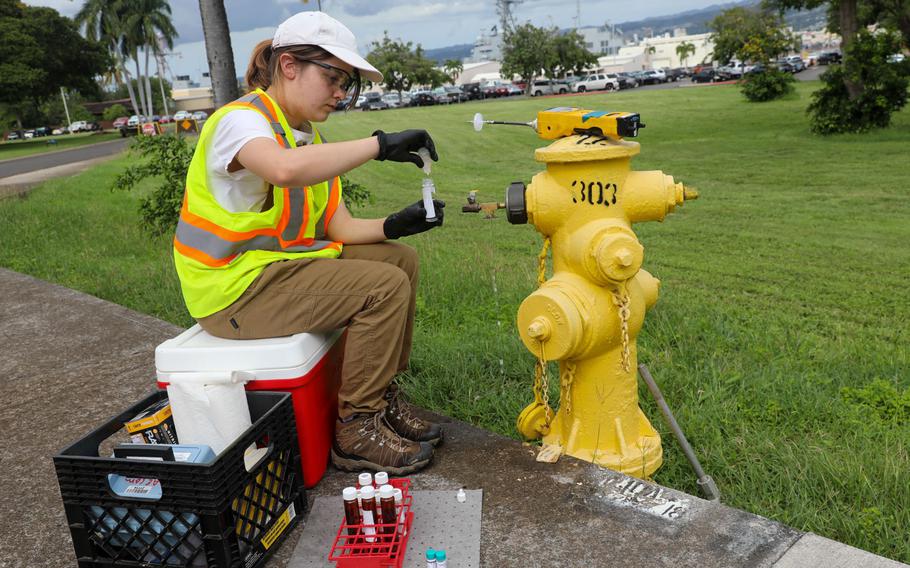
A Navy contractor collects water samples Jan. 31, 2024, as part of a long-term drinking water monitoring program at Joint Base Pearl Harbor-Hickam, Hawaii. (Krystal Diaz/U.S. Navy)
FORT SHAFTER, Hawaii — The Navy should rethink its protocols for analyzing groundwater samples near the defunct Red Hill underground fuel storage facility in Honolulu in response to questions over testing methods and a chemical plume in the aquifer, a municipal engineer said recently.
“Our ask right now is simply to increase the frequency of testing.” Ernest Lau, chief engineer and manager for the Oahu Board of Water Supply, said on Aug. 23 at his Honolulu headquarters. The board manages Oahu’s municipal water resources and distribution system.
“Drilling more monitor wells is going to take years,” he said, adding that he believes dozens more are needed. “But in the meantime, just to give a better resolution of what might be happening below in the underground aquifers, [we should] move to weekly testing.”
In response, a Navy contractor involved in the program said the tests are viable, and the sampling schedule is already “pretty much every day out there.”
The massive World War II-era Red Hill facility, about three miles northeast of Joint Base Pearl Harbor-Hickam, is being dismantled and permanently closed after a 2021 jet fuel leak there contaminated the Navy’s water distribution system.
Thousands of residents living in military communities on and near the joint base were forced to temporarily relocate as the Navy flushed its distribution system.
One of the three wells used by the Navy was isolated from the system and remains contaminated with jet fuel.
Navy Closure Task Force-Red Hill is charged with dismantling the facility and cleaning up contaminants on and below the site, a process that will take many years.
The water board in tests this summer detected traces of polycyclic aromatic hydrocarbons, or PAH, in samples taken from its wells in Aiea, about two miles northwest of the fuel facility.
PAH are a class of naturally occurring chemicals found in coal, crude oil and gasoline, but are also produced when things such as wood, garbage and tobacco are burned, according to a U.S. Environmental Protection Agency fact sheet.
The origins of that PAH plume are unknown, but Lau considers the Red Hill facility, which has an 80-year history of leaks and spills, to be a chief suspect.
In a July 8 letter to the EPA and the Hawaii Health Department that detailed the plume, Lau urged the regulatory agencies to require the Navy to quickly identify the nature and extent of fuel contamination in the aquifer, complete a groundwater flow model and mitigate any contamination in the groundwater.
The agencies pushed back on Lau’s contention in an Aug. 9 letter, saying the plume had more likely originated from a source closer to the Aiea wells.
Navy contractor Chris Waldron, who has been involved in the Navy’s water testing since 2021, reiterated several of the agencies’ points by phone on Aug. 28.
“There’s a lack of detections of PAH in the groundwater wells located between the Red Hill facility and the Board of Water Supply’s Aiea wells,” said Waldron, an environmental engineer.
“If there were a groundwater plume migrating from the Red Hill facility to Aiea, we would have expected to detect compounds in the wells that are located between the Red Hill facility and Aiea, and that hasn’t happened,” he said.
Waldron also pointed to the Board of Water Supply’s own documentation about the direction of groundwater flow in that aquifer.
“It flows kind of towards the Red Hill facility, not the other way around,” he said.
Lau has asked the Navy to step up the testing of its monitor wells from biweekly to weekly.
Waldron said the way sampling is now done on the roughly 40 monitoring wells is essentially already weekly.
“The sampling is not all performed on the same day, so it’s spread out over many different days just due to the number of wells that need to be sampled,” he said. “So, we’re actively collecting samples, you know, pretty much every day out there.”
Lau cited consultants who questioned the Navy protocols and asked that an independent third party test the samples from the Navy’s monitor wells
The two firms retained by the water board concluded in separate reports this summer that the roughly 8,000 water tests conducted by the Navy since late 2021 were too flawed to detect traces of total petroleum hydrocarbons, or TPH.
TPH refers to hundreds of compounds found in petroleum-based products, and it can serve as an indicator of contamination.
Analytical Quality Associates, based in Albuquerque, said in its July 5 report that it “found the existing data to be very suspect and, thus, would qualify it as unusable for the purpose of proving the absence of jet fuel in the drinking water system.”
The consultants presented their findings during an Aug. 26 meeting of the Board of Water Supply.
Waldron said he has not yet completely reviewed those studies but that he “fundamentally and wholeheartedly” disagrees with the conclusion that the tests are unusable.
A detailed formal response is forthcoming, he said.